
Chennai is one of the 98 cities to be developed as a Smart City as announced by the Central Government recently. But the city has a long way to go before it can become one.
The massive downpour in the city recently not only disrupted normal life but crumpled the city’s infrastructure. The city had received 170 percent excessive rainfall than expected. It was the highest recorded rainfall in last 10 years. Several areas in the city were submerged in water; subways and underpasses were completely filled up and lakes water levels had almost reached the edge. In short, the existing infrastructure had failed due to rapid urbanization and unplanned growth in a worst manner.
Like most of the other metros in the country, Chennai too has been growing at a rampant speed. It has been attracting the migrant population from rural areas there by putting a pressure on the existing infrastructure. This resulted in encroachments, unplanned constructions, poor waste management, shortage of water, power and land for development. Infrastructure is the backbone of any economy and a city like Chennai that is prone to heavy rainfall requires robust infrastructure. It is imperative to upgrade the existing infrastructure while we create sustainable cities with newer infrastructure.
Better sewage disposal system, waste management, planned residential and commercial development, presence of large open spaces, zero disturbance to natural water bodies, efficient transport networks and above all better co-ordination between planning agencies are some of the essential facets to redesign an existing city like Chennai. A detailed research on the problems with use of state-of-the-art technologies can create better solutions for the city. Private institutions are equipped with research facilities, manpower, technology and funding that opens up the option of public-private-partnership models for redesigning cities to make them environment friendly.
Surendra Hiranandam, Md, Hiranandani Group

The integrated township developed by us at Egattur, Chennai is one such example which shows the benefit one can derive by creating proper infrastructure. During the recent rains when most of the areas in the city were water logged, our property was least affected and we received wide spread appreciation from the residents. The company attributes this feat to the planned construction, green construction practices and developments in tandem with nature.
Some of the highlights of the construction carried out by us include provision of rain water harvesting, provision for maximum water percolation in the ground through use of paver blocks with sand cushion, creating recharge wells, storm water drains on both sides of roads, well planned and well-designed roads, properly planned building level and vast open spaces and greenery in the vicinity. These features enabled better disposal of rain water with zero water logging in the vicinity.
This is a small yet significant example of planned and nature friendly development. If we attempt to replicate such planned development in every location of the city, probably Chennai can become a smart city in its true sense in the days to come. Authored by Mr. Surendra Hiranandani, CMD, House of Hiranandani, is the leader in quality constructions and real estate development. He has more than 35 years of work experience in the constructions industry and is the technical and architectural genius behind the Company’s outstanding reputation for quality and innovation.
Courtesy by www.businesswire.com




